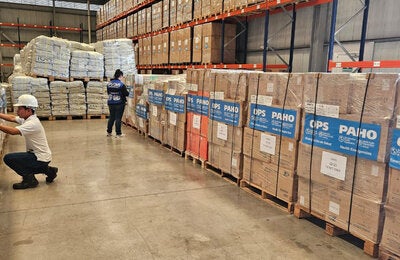
Washington, D.C., October 1, 2024 (PAHO) – At its 61st Directing Council, Member States of the Pan American Health Organization (PAHO) approved a new policy on health, climate change, and equity. The policy seeks to strengthen the health sector, improve climate change adaptation and mitigation, ensure the participation of vulnerable communities, and optimize surveillance systems, as well as increase climate and health financing.
The policy comes in the context that the Region of the Americas is “one of the most vulnerable due to its susceptibility to extreme weather events, economies that depend on climate-sensitive sectors and high levels of social inequality,” the document states.
In addition, “climate change threatens to worsen existing health inequities, disproportionately affecting populations and territories in vulnerable situations,” said the director of the Department of Social and Environmental Determinants for Health Equity, Gerry Eijkemans. This is why “the health sector must take immediate and decisive action on climate change and health, with specific efforts to integrate equity in adaptation and mitigation measures,” she added.
The approved text considers it “imperative” to take measures to “make the health sector greener” while continuing to respond to unmet health needs, especially underserved communities and vulnerable population groups, such as the poorest populations, Indigenous Peoples and migrants, among others”.
The Policy to Strengthen Equity-Oriented Health Sector Action on Climate Change and Health is articulated around five lines of action, namely:
- Strengthen the health sector’s capacity for adaptation to anticipate, prevent, prepare for, respond to, and recover from the impacts of climate change while reducing health inequities.
- Strengthen the capacities of the health sector for mitigation to build low-carbon health systems and societies, aimed at achieving health co-benefits and reducing health inequities.
- Create awareness and strengthen community and civil society participation on climate change and health, using an equity- and human rights-oriented approach.
- Improve the surveillance of climate change and health, and the generation and use of evidence, for the design and implementation of adaptation and mitigation strategies that protect health and reduce health inequities.
- Increase health sector financing for climate change adaptation and mitigation with an emphasis on populations in situations of vulnerability.
The policy is in line with the World Health Organization (WHO) Resolution on Climate Change and Health, 2024, as well as the WHO Global Strategy on Health, Environment and Climate Change, 2019, and the United Nations Framework Convention on Climate Change.
Health equity approach
The policy draws attention, among other phenomena, to how “heat waves have led to a 160% increase in heat-related deaths in South America over the past 20 years,” or to the ongoing increase in vector-borne diseases such as dengue or malaria, and the rise of increasingly extreme weather events that require more resilient and greener health systems and services.”
However, the document highlights that “the effects of climate change are not the same for all people”. The degree of vulnerability depends on a wide range of intersecting conditions, such as socioeconomic status, ethnicity, age, disability, migration status, sex, gender, geographic location, among others.
Crucially, climate change threatens to worsen existing health inequities, disproportionately affecting vulnerable populations and territories.
The document specifically mentions the “threat” posed by climate change to the way of life of Indigenous Peoples and other ethnic groups “due to their close relationship with the environment.”
Vulnerability to the effects of climate change “is also uneven among the countries and territories of the Region”. The document approved by the countries warns that “climate change may even be a potential threat to the existence of small island developing States that are affected by rising sea levels.”




